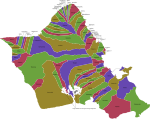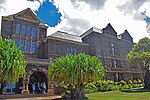Fort Shafter
1907 establishments in HawaiiBuildings and structures in HonoluluForts in HawaiiGovernment buildings completed in 1907Historic American Buildings Survey in Hawaii ... and 2 more
Historic American Landscapes Survey in HawaiiUnited States Army posts

Fort Shafter, in Honolulu CDP, City and County of Honolulu, Hawai‘i, is the headquarters of the United States Army Pacific, which commands most Army forces in the Asia-Pacific region with the exception of Korea. Geographically, Fort Shafter extends up the interfluve (ridgeline) between Kalihi and Moanalua valleys, as well as onto the coastal plain (as Shafter Flats) at Māpunapuna. A portion of the area is also known as the Palm Circle Historic District; it is listed on the National Register of Historic Places and has been further designated as a U.S. National Historic Landmark. It is also known as Palm Circle or 100 Area.
Excerpt from the Wikipedia article Fort Shafter (License: CC BY-SA 3.0, Authors, Images).Fort Shafter
Funston Road, Honolulu Moanalua Gardens
Geographical coordinates (GPS) Address Nearby Places Show on map
Geographical coordinates (GPS)
| Latitude | Longitude |
|---|---|
| N 21.345 ° | E -157.884 ° |
Address
Amphitheater
Funston Road
96858 Honolulu, Moanalua Gardens
Hawaii, United States
Open on Google Maps





